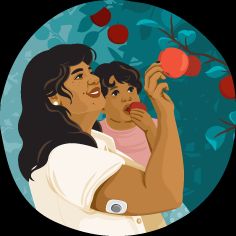While certain types of eye drops may help relieve eye allergies, you may need other allergy-specific treatments to fully manage symptoms.
When an allergen affects your eyes, either from direct exposure or as part of a full-body response, your eyes may increase tear production to flush out allergens and soothe related irritation.
Eye allergies are also known as ocular allergies or allergic conjunctivitis.
It’s unclear why certain people experience allergies when others don’t.
When allergies cause itchy, watery, red, or puffy eyes, different over-the-counter (OTC) products and prescription therapies can help.
Keep reading to learn about the options for eye allergy relief.
Artificial tears are OTC products designed to help lubricate the eyes. They generally treat dry eyes but can also help flush out allergens.
Artificial tears do not stop an allergic reaction because they don’t contain antihistamine ingredients. However, they may help lessen an allergic response by removing the irritant.
Some artificial tear products contain preservatives to help prevent bacterial growth in the droppers. Preservatives can cause their own form of eye irritation, especially with prolonged or frequent use. Some people may also have allergic reactions to different preservatives.
When selecting artificial tears, consider preservative-free options, especially if you need to use artificial tears often. You can also refrigerate products to help increase their soothing effect on the eyes.
You can purchase antihistamine eye drops over the counter, or a doctor can prescribe them in stronger formulations. They contain antihistamines, chemicals that bind to the same receptor sites in the body as histamine, blocking its effects.
Different antihistamines provide varying levels of relief. In eye drop form, they may only help for a few hours, and you may need to use them multiple times daily.
Many OTC and prescription antihistamine drops also contain mast cell stabilizers. Unlike antihistamines, which only block the effects of histamine, mast cell stabilizers work to prevent histamine release.
Mast cells are a part of your body’s allergic response. With mast cell stabilizers, the mast cells are less likely to become activated by allergens and less likely to release inflammatory chemicals like histamine.
Eye decongestants can help reduce allergy symptoms affecting the eye by constricting the blood vessels.
In your eyes, blood vessel constriction makes blood vessels appear less visible, reducing redness.
Decongestant eye drops don’t prevent or stop an allergic reaction. They may help reduce redness from eye allergies, but they’re not meant for long-term use.
The American College of Allergy, Asthma & Immunology (ACAAI) recommends not using decongestant eye drops, or “red eye” eye drops, for more than several days. Prolonged use may cause rebound redness, a condition in which the vessels of the eyes dilate beyond their regular size after the medication wears off.
Oral antihistamines, available by prescription or over the counter, may also help relieve eye allergy-related discomfort. They block the effects of histamines on a systemic, or whole-body, level.
Your doctor may recommend adding or primarily using an oral antihistamine for several reasons.
Not all allergic reactions that cause eye symptoms are related to direct exposure to an allergen. When released by other parts of the body through allergen exposure, histamine can also affect the eyes and cause symptoms.
Oral antihistamines may offer more extended relief than eye drops. Many can work in the body for 12 to 24 hours. Oral medications can offer a reliable alternative if you cannot continually apply antihistamine eye drops.
Adding an oral antihistamine to antihistamine eye drops may offer more complete management of allergic reactions throughout the body, even if they originate in the eyes.
Allergy shots, also known as allergen immunotherapy, work like vaccines do. They expose the body to small amounts of an allergen to promote tolerance and build immunity.
Allergy shots do not immediately relieve the symptoms of allergies. In other words, if you’re experiencing an eye allergic reaction, your doctor won’t give you an allergy injection to make those symptoms go away.
Instead, allergy shots help ease the symptoms of eye allergies over time. The more you’re exposed to manageable amounts of an allergen, the more your body can recognize that it isn’t a threat when the immune system encounters it.
Allergy shots work differently for everyone. They may not be as effective if you’re exposed to high environmental allergen levels or are allergic to multiple irritants.
If you have severe eye allergy-related discomfort, your doctor may prescribe other types of medications besides antihistamines.
- Nonsteroidal anti-inflammatory drugs, in eye drops or oral forms, can reduce inflammation and help relieve the pain and discomfort associated with eye allergies.
- Corticosteroids, available by prescription in eye or drop oral forms, can help suppress the immune response that causes allergies. They work to prevent the production of specific inflammatory substances in the body that contribute to allergy discomfort.
An allergy is a type of hypersensitivity reaction in the body. It occurs when your immune system mistakes typically harmless particles as potential threats, producing an immune response. Histamines, chemicals released by the body during an allergic reaction, cause itchiness and inflammation.
Allergy-related eye discomfort can come from various sources, including:
- pollen
- pet dander
- mold
- dust
Contact with an allergen may cause symptoms that affect the eyes, even if the allergen doesn’t get into the eyes. Symptoms affecting the eyes can include:
- redness
- itching
- swelling
When it comes to eye allergies, prevention is key. Taking steps to avoid exposure to known allergens can help reduce your need for treatment.
According to the ACAAI, here are some tips for avoiding exposure:
- Stay indoors as much as possible if you’re allergic to outdoor allergens.
- Avoid using fans that may circulate allergens.
- Don’t touch your eyes with unwashed hands.
- Wear glasses when outside to protect your eyes.
- Use air conditioning in buildings and cars instead of opening windows.
- Avoid dry dusting or sweeping.
- Wash bedding frequently in water temperatures of at least 130°F (54°C).
- Use mite-proof linens.
- Keep indoor humidity between 30% and 50% to limit mold growth.
- Keep pets out of the bedroom if you’re allergic to their dander.
- Consider cleaning your air vents.
- Wash your hands immediately after touching a known allergen.
- Change or shower and wash your clothes after being outside your home.
Eye allergy-related discomfort comes from an immune response that produces redness, inflammation, and itching.
Eye drops, oral medications, and allergy shots may all help relieve symptoms of eye allergies. However, certain products may not be safe to use long term.
Because improper eye drop use can worsen some eye conditions, it’s important to speak with an eye doctor or allergist before trying a new product.






